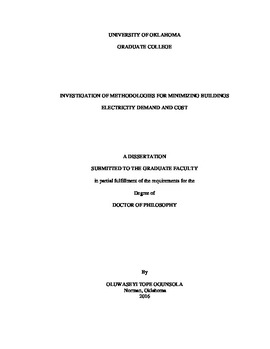| dc.description.abstract | Heating, ventilating, and air conditioning (HVAC) systems are the largest consumer of electricity in buildings. The HVAC system is complex in terms of components that make them up and their different time scales. The inefficient operation of HVAC system leads to unreasonable electricity consumption during peak periods, which is accompanied by high cost of electricity use. The dynamic changes in building demand, contributions from exogenous inputs such as solar radiation and ambient temperature, and phenomenon such as radiative delays, thermal storage, internal mass etc. are some of the current challenges in buildings systems operation. Due to dynamic and thermal coupling between the conditioned building and HVAC systems components, optimal control is difficult to achieve.
In a multi-zone building, multiple thermal interactions among the different thermal zones and the effects on electricity demand and cost are not well understood, due to lack of fundamental knowledge. The existing strategies for electricity demand and cost control do not consider the dynamics of building construction and multi-zone interactions in their formulation. As a result, existing demand and electricity minimization strategies are not consistent in their conclusions. Meanwhile, multi-zone interactions and building dynamics play a crucial role in the overall electricity demand, cost, and load profiles due to the dependency of states of each individual zone on the thermal characteristics and states of the adjacent zones. The objective of this research is to understand multi-zone and equipment interactions in buildings energy systems, in order to minimize electricity cost. This is the first research to integrate building dynamics into controller formulation and design through the use of a physically representative thermal model that captures important phenomenon of building load and cooling coil operations.
The intellectual contribution of this research is the understanding of multiple-zone interactions in buildings to aid in effective decision making regarding the operational states of HVAC equipment that minimizes overall electricity cost. Other original contributions are identification of critical thermal zones in a multi-zone building, extension of the R-C thermal network approach for transient modeling of cooling coils, identification of new methods (near constant cooling and temperature recovery/optimal start) for minimizing buildings electricity demand and cost, downsizing of heating system size based on passive thermal storage properties of building construction, and demonstration of the electricity cost savings capabilities in air handling units operations through the use of Model predictive control (MPC) methods. This is the first research to demonstrate predictive control that utilizes building dynamics through the use of models that represent the building physically and captures important phenomenon e.g. radiative delays and thermal storage. Therefore, it provides opportunities to strategically maximize curtailment potentials and human comfort through optimization, and contributes to knowledge through the development of step by step approach to achieve system-wide optimal operation of the air handling unit, based on consideration of time of use electricity tariff. Therefore, the developed framework in this dissertation is useful for smart grid integration, and for building modelers in the areas of fault detection and diagnosis (FDD) and control. As such, the developed framework is very promising for existing and future building automation system (BAS) and emerging technologies in the building sector. | en_US |
